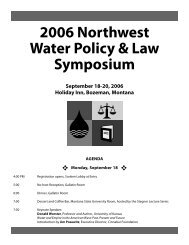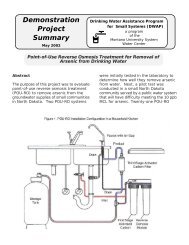aquaculturehealth - Montana Water Center - Montana State University
aquaculturehealth - Montana Water Center - Montana State University
aquaculturehealth - Montana Water Center - Montana State University
Create successful ePaper yourself
Turn your PDF publications into a flip-book with our unique Google optimized e-Paper software.
FINFISH<br />
A US PERSPECTIVE<br />
ON ADVANCEMENTS IN<br />
FISH VACCINE DEVELOPMENT<br />
BY DR PHILLIP KLESIUS, DR JOYCE EVANS AND DR CRAIG SHOEMAKER<br />
(UNITED STATES DEPARTMENT OF AGRICULTURE, AGRICULTURE RESEARCH SERVICE, AQUATIC ANIMAL HEALTH<br />
RESEARCH LABORATORY, AL AND CHESTERTOWN, MD)<br />
During the past decade,<br />
aquaculture production has<br />
significantly increased in<br />
many parts of the world. Seafood<br />
provides 16 percent of the animal<br />
protein consumed by humans.<br />
From 1992 to 2001, the United<br />
Nations’ Food and Agriculture<br />
Organisation (FAO) reported that<br />
total seafood supply increased by<br />
29.8 percent, whereas the supply of<br />
wild-captured fish increased by<br />
only 8.3 percent. The FAO also<br />
reported that global aquaculture is<br />
increasing by 11 percent per year<br />
and is the world’s fastest growing<br />
food-producing sector. More recent<br />
FAO figures have also confirmed this trend.<br />
The incidence and emergence of new infectious diseases has<br />
almost paralleled the growth of the aquaculture industry. The<br />
increasing impact of infectious diseases on production is likely to be<br />
the result of sub-optimal production husbandry practices, intensive<br />
culture at high fish densities, the lack of health management<br />
practices and the introduction of sick fish to healthy populations.<br />
The movement of fish, eggs and genetic material from country<br />
to country has resulted in the introduction of new diseases for<br />
which the fish have little or no resistance. The overall economic<br />
impact of fish diseases is difficult to determine, but may be as high<br />
as 10 to 15 percent of the total value of fish production worldwide.<br />
Certain diseases may destroy the entire production chain, and<br />
often result in the destruction of healthy fish in the affected area in<br />
an effort to control the epizootic from spreading to other regions<br />
or countries.<br />
The aquaculture industry has made remarkable biotechnological<br />
advancements in the past five years. These advancements in areas such<br />
as fish vaccines are necessary to meet the rapid growth of the<br />
aquaculture industry worldwide. The use of vaccines for humans, food<br />
animals and pets to prevent disease is a common practice. Similar<br />
biotechnological advancements in the development of efficacious fish<br />
vaccines for disease prevention in cultured fish are on the rise.<br />
From 1976 to the present, the number of commercially available,<br />
safe and efficacious fish vaccines has increased from one to more than<br />
14. The majority of these vaccines are to prevent bacterial diseases.<br />
However, several vaccines are also available to prevent viral diseases.<br />
The majority of the available bacterial vaccines are of the killed<br />
type (i.e. the infectious agent(s) are inactivated or killed). Killed<br />
vaccines are primarily administered by injection and are therefore<br />
costly because of the need to handle and inject each fish.<br />
KILLED STREPTOCOCCAL VACCINES<br />
Streptococcus iniae and Streptococcus agalactiae are major pathogens<br />
that cause serious economic losses in tilapia and numerous species<br />
IMMUNOFLUORESCENT ANTIBODY STAINED EDWARDSIELLA ICTALURI<br />
(RED) AND FLAVOBACTERIUM COLUMNARE (GREEN).<br />
(Courtesy of Dr Victor Panagala, USDA, ARS,<br />
Aquatic Animal Health Research Laboratory)<br />
of freshwater, marine and estuarine<br />
fish worldwide.<br />
Efficacious S iniae (US Patent<br />
6,379,677 B1) and S agalactiae<br />
(patent pending) vaccines were<br />
developed and patented by the<br />
Agricultural Research Service,<br />
Aquatic Animal Health Research<br />
Laboratory at Auburn, AL and<br />
Chestertown, MD using<br />
formalin-killed cells and<br />
concentrated extra-cellular<br />
products.<br />
A specific antibody response<br />
appears to confer protection for<br />
both the S iniae and S agalactiae<br />
vaccines. The finding that extracellular<br />
products of these Gram-positive streptococci are<br />
important immunogens that confer protective immunity<br />
following immunisation is a notable advancement in the<br />
development of efficacious killed vaccines. Indeed, commercial<br />
vaccines are now on the market.<br />
ATTENUATED VACCINES<br />
The development of attenuated bacterial vaccines was a<br />
biotechnological breakthrough. Attenuated vaccines are made by<br />
changing virulent pathogens so they retain the ability to infect and<br />
cause the host to mount an effective immune response without<br />
causing mortality, adverse reactions or reverting to the virulent form.<br />
Attenuated vaccines can be successfully administered by bath<br />
immersion, a cost-effective method of mass immunisation of large<br />
numbers of fish. Equally important, attenuated vaccines can be<br />
successfully used to immunise fingerlings and fry as young as<br />
seven to 10 days after hatching. This immunisation will last the life<br />
of their production cycle, as opposed to a shorter duration of<br />
about six months for a killed vaccine.<br />
Examples of the first US-licensed attenuated bacterial vaccines<br />
are those against enteric septicemia of catfish (ESC) and<br />
columnaris disease of catfish. These attenuated vaccines were<br />
developed and patented by the Agricultural Research Service,<br />
USDA, Aquatic Animal Health Research Laboratory at Auburn, AL<br />
(US patents 6,019,981 and 6,881,412). Edwardsiella ictaluri,the<br />
causative agent of ESC, costs the catfish industry about US$50-60<br />
million annually.<br />
Columnaris disease caused by the bacterium Flavobacterium<br />
columnare, costs the catfish industry about $40 million annually.<br />
Both diseases are generally found together, compounding these<br />
industry losses. The Agricultural Research Service, USDA, licensed<br />
both vaccines to Intervet, Inc, Millsboro, DE which<br />
commercialised the vaccines.<br />
The ESC and columnaris vaccines are commercially labeled<br />
Aquavac-ESC® and Aquavac-COL®, respectively. The economic<br />
20 AQUACULTURE HEALTH INTERNATIONAL FEBRUARY 2006






